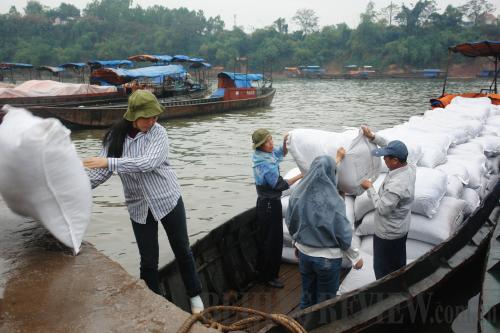|
 It was not only the birth of a new decade. January 1 also witnessed a day of celebration on the mainland and beyond after Beijing and its partners in the Association of Southeast Asian Nations (ASEAN) fully established the China-ASEAN Free Trade Area (CAFTA). It was not only the birth of a new decade. January 1 also witnessed a day of celebration on the mainland and beyond after Beijing and its partners in the Association of Southeast Asian Nations (ASEAN) fully established the China-ASEAN Free Trade Area (CAFTA).
Covering an area of 14 million square km and encompassing a population of some 1.9 billion people, CAFTA has emerged as the world's most populous free trade area (FTA). This is underscored by statistics such as its GDP of $6 trillion, and trade volume of $4.5 trillion.
Successful beginnings
In all, it took a mere decade from the conception of CAFTA to its final completion. This, however, is hardly unheard of when it comes to setting up an FTA living up to World Trade Organization (WTO) requirements with only two members.
Nevertheless, forging a free trade alliance of 11 members with different economic levels in 10 years is still something truly remarkable. More importantly, CAFTA is a large FTA that conforms to WTO regulations while featuring a perfect integration of free trade in goods and services and investment liberalization. This represents only one more reason to make this progress one worth learning from.
Not surprisingly, it is no secret that CAFTA's biggest significance lies in its promotion of bilateral trade between China and ASEAN.
Since the China-ASEAN Agreement on Trade in Goods came into effect in 2005, according to China's Ministry of Commerce, China has leapt from being ASEAN's sixth largest trading partner to its third largest trading partner. ASEAN, meanwhile, has stood as China's fourth largest trading partner for many consecutive years.
In fact, bilateral trade volume rose to $231.1 billion in 2008, up from $78.2 billion in 2003, representing an average annual growth rate of 24.2 percent.
Under even the greatest strains from the global financial crisis, the fall of China-ASEAN trade volume was far lower than that between China and other regions and nations. Within the first three quarters of 2009, the China-ASEAN trade volume was still close to $150 billion.
 |
|
A RIVER RUNS THROUGH IT: Local business people load goods ashore from Viet Nam in a border trade zone in Dongxing, Guangxi, on January 1 (XINHUA) | These figures have decisively demonstrated CAFTA's resilience and leadership in the face of the financial crisis. China's huge import market, for one thing, notably eased economic recessions among ASEAN member states resulting from shrinking demand for foreign exports.
Indeed, the establishment of CAFTA has also accelerated the bilateral investments between China and ASEAN.
Since China and ASEAN officially began to negotiate an FTA in November 2002, bilateral investments have surged. By the end of 2008, ASEAN's actual investments in China had hit $52 billion, accounting for 6 percent of the total foreign investment volume in China.
In recent years, Chinese business giants have been eager to establish an international presence. Since the China-ASEAN Investment Agreement was signed in 2009, they have increasingly regarded ASEAN nations as destinations for foreign direct investment. In 2008, China's direct investment in ASEAN reached $2.18 billion—up by 125 percent from the previous year.
Beyond this, CAFTA intends to help reduce poverty, which, as of now, is a serious regional problem, among all member countries. Income disparities between urban and rural areas, coupled with inadequate development, are prevalent in many countries in the region.
CAFTA plans to address these inequities with tariff reductions on agricultural exports and imports. The growth of trade in fruits, vegetables and meat will lead to the development of agriculture and animal husbandry. CAFTA is also expected to help boost the economic growth of its member states, thus enabling them to devote more resources to poverty alleviation.
Moreover, CAFTA will seek to promote further integration within the East Asian region. It has thus far directly stimulated the development of the Japan-ASEAN FTA and the South Korea-ASEAN FTA. It has additionally inspired efforts to seek an FTA between China, Japan and South Korea, as well as an FTA for greater East Asia.
The success of CAFTA's establishment speaks to the quality of its innovation. Its "early harvest program," for example, deals with agriculture, the most contested area in free trade negotiations. But from the beginning, Chinese officials proactively planted seeds for cooperation. "Let the ASEAN countries pick the peaches first," was a remark heard more than once from Chinese negotiators.
Agricultural exports have proven highly competitive among many less-developed ASEAN countries. Thus, the "early harvest program" has enabled them to benefit first. Now, not only has the program been learned and applied by many other FTAs, it has also been used in the Doha Round negotiations of the WTO.
Another innovation has included a two-track approach to states relative to their levels of economic development. As the 10 ASEAN nations differ dramatically in terms of their economic prosperity, in other words, CAFTA has adopted two timetables. The slower track will be offered to the four less developed countries—Viet Nam, Laos, Myanmar and Cambodia. They can enjoy a transitional period of three to five years.
Incremental steps have been a plus, too. This began through gradual tax cuts in trade in goods, to the progressive opening up of the services market, followed by the step-by-step liberalization of investments. Companies in CAFTA member countries, meanwhile, are accepting the opening of the market in a gradual, calibrated way.
| 